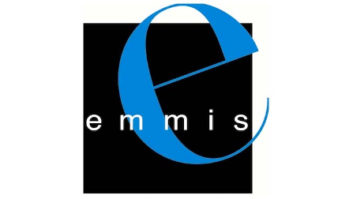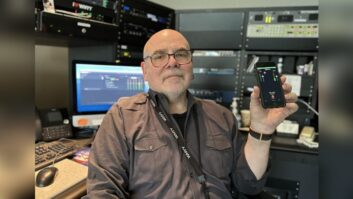Fresh Digs for Emmis Terre Haute
Apr 1, 2013 7:35 AM, By Chriss Scherer, editor

Emmis Communications became a station owner in Terre Haute, IN, in 1998 when it bought WTHI and WWVR. At the time, the stations were co-owned with and housed in the same building as WTHI-TV. The TV station signed on in 1954 from a facility in the heart of downtown Terre Haute. The original TV tower, which supports WTHI-FM, still stands on the site.
After more than 50 years, this original studio facility was due for an upgrade. Emmis began selling its TV stations in the mid-2000s, so the radio stations were looking for a home of their own by 2012.
A local developer had plans to build a new office building next to the former studio building. With one FM using the tower as its main transmitter site, the new office building was an ideal location. Emmis made plans for the move.

TOC
The new and the old
The WTHI-FM transmitter was installed on the third floor of the former studio building. With the pending move, the first step was to build a new transmitter building at the base of the tower. This was completed while the new office building was being built.
To relocate the transmission facilities, one transmitter was moved to the new transmitter building, and the coax feeding the antenna was pulled out of one building, rerouted down the tower and attached to the newly installed transmitter switch. Then the second transmitter was moved into place. Axia Nodes were installed in the new transmitter building and in the old studio to handle the audio. Once the new studios were complete, an audio switch from the old studios to the new studios was seamless.
Once the new studio building was complete, Kendall Myers, chief engineer of the Emmis stations, got to work building the new studios. Equipment had been ordered, and some prewiring had been completed to speed the installation process. Myers also selected an Axia audio system for the facility.
– continued on page 2
Fresh Digs for Emmis Terre Haute
Apr 1, 2013 7:35 AM, By Chriss Scherer, editor
From the time Myers was given access to the new facility, it took two weeks to complete the installation of the new equipment. The two stations moved into their new homes in August 2012. Shortly after, Emmis closed on the purchase of two more stations: WFNF-AM and WFNB-FM. The construction plans included these stations, so it was an easy matter to get them on the air in the new 4,100 square-foot facility.

On the air
Not long after the radio and TV stations moved out of the old facility, the building was razed. Within months, work began to convert that area into a parking lot.
Making connections
Because of the audio network, transferring the audio feeds from the old to the new operation was easy. A temporary fiber optic cable was run from the old studios to the new transmitter building, which could feed the on-site transmitter and the other station”s STL. A fiber optic cable also runs from the new technical operations center rack room to the transmitter building. Axia Nodes placed at each end made switching the audio as simple as pressing a button.
When WFNB and WFNF came in, their STLs were mounted on the tower and audio was fed from the fiber optic cable.

WTHI air studio
There are six 6″ conduits run between the rack room and the transmitter building. There’s plenty of future capacity; all the connections between the two rooms is via a single, 12-strand fiber optic cable. Even the satellite connects to the fiber. The L-band LNB output is converted to a digital signal and multiplexed on the fiber. The feed is demuxed in the rack room to feed the satellite receivers. This places the satellite receivers within the studio area, but not at the expense of running several hundred feet of coax, and without the resulting RF losses.
– continued on page 3
Fresh Digs for Emmis Terre Haute
Apr 1, 2013 7:35 AM, By Chriss Scherer, editor
There are four studios in addition to the rack room. Three of the studios are nearly identical, with two of them (WWVR and production) being mirror images. The studio for WTHI has an additional space for a cohost or visiting guests. These three studios have Axia iQ consoles. The fourth studio is a smaller voice-tracking room, which uses an Axia Radius console.

WWVR air studio
WFNB and WFNF are currently fully automated and run in the background from TOC.
Myers was impressed by the process to order the Omnirax furniture. He supplied CAD drawings of the facility to Omnirax, who then virtually placed the furniture within. Myers had an idea as to what the studios would look like before the furniture was even manufactured.
The stations use WideOrbit for their audio storage and playback. For mic processing, Wheatstone Vorsis M-2 mic processors are installed in the rack room. Because the mic processors are controlled remotely, it’s easy to get in and make changes as needed. Installing the mic processors in the rack room also made it easy to tie them into the audio network.
All four stations send audio to the transmitter building via the fiber optic run and the Axia network. From there, the three off-site transmitters are fed via RF-based STLs with Mosely PCL-6000 and Marti STLs. A Comrex Access and Bric, Moseley Rincon and Telos Z/IP are available as backups if needed.

Voice over studio
The rack room is adjacent to the studios, although accessed via the common hallway. While it was not the ideal setup to have the rack room accessible from outside the studio area, the floor layout dictated it be that way. As an added surprise, once the plans were set it was realized there was a structural support beam in the rack room, which dictated the L configuration of the racks.
There are five racks in the rack room. Two support the office network and phone system. Three support the audio network and audio equipment. The CAT-5 and CAT-6 cabling used throughout the facility is color-coded for easier identification. Blue is used for the audio network. Black is used for analog audio.
After more than 50 years in one studio building, the Emmis stations have started writing a new history in a new facility.
– continued on page 4
Fresh Digs for Emmis Terre Haute
Apr 1, 2013 7:35 AM, By Chriss Scherer, editor
Equipment List
Axia IQ, Radius, QOR32, various nodes
Blonder-Tongue FILR S4A-3000
Broadcast Tools ACS 8.2 Plus
Broadcasters General Store (primary equipment dealer)
Cisco Catalyst 3560G
Comrex Access, Bric
ESE ES-185U
EV RE27N/D
General Wire and Cable
Mika mic and monitor stands
Moseley Lanlink
Moseley PCL-6000, Rincon
Omnirax Phoenix
Quintech LS series
Telos One, Z/IP One
Titus Labs on-air lights
Tripplite Smartpro UPS, KVM extenders
Videotek APM-200
Wheatstone Vorsis M-2
WideOrbit automation
Yamaha HS80M

The 1950s tower

New building from the street
April 2013
Remote access, inside Emmis Terre Haute, Field Reports on the Rode Reporter and Belar FMCS-1, working with Corian and more products at the 2013 NAB Show….












